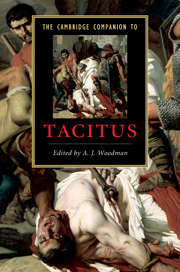2 - Tacitus and the contemporary scene
from Part I - Contexts
Published online by Cambridge University Press: 28 March 2010
Summary
Tacitus' first historical work can be dated with unusual precision. Internal evidence indicates that he was writing the preface to the Agricola between October 97 and late January 98 and that he was finishing the work after Trajan had become emperor (3.1, 44.5). Since we know from Pliny (Ep. 2.1.6) that Tacitus was suffect consul in 97, he may even have started writing the Agricola while still in office. Tacitus described the Agricola (3.3) as an 'interim book' and said that in due course he would write a larger work covering both the reign of Domitian (81-96) and the present time. This larger work, which we know as the Histories and which in the event covered the years 69-96 but excluded the present time, was in progress around 107, since that is the approximate date of the letter in which Pliny refers to it (Ep. 7.33.1). In the Histories (1.1.4) Tacitus repeated his promise of writing about the present time, but in his last and most celebrated work, the Annals, he went further back still to the years 14-68. The composition of the Annals seems to belong to the period after 113, when he returned from his proconsulship of Asia, but the precise dates are unknown. Of his two other shorter works, the Germania is assumed to have been written in 98; the date of the Dialogus remains unclear: the most likely year is perhaps 102, when Fabius Iustus (to whom the work is dedicated) was consul; but this is not certain and the evidence is disputed.
- Type
- Chapter
- Information
- The Cambridge Companion to Tacitus , pp. 31 - 44Publisher: Cambridge University PressPrint publication year: 2010
- 16
- Cited by

